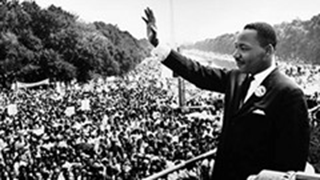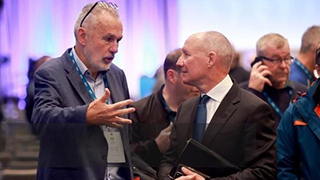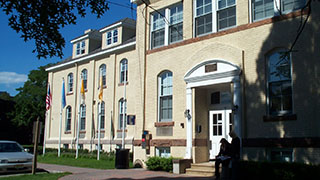Inside the Core: Martin Luther King’s “Mountaintop Speech"
Monday, November 17, 2025

Martin Luther King, Jr.
Inside the Core many Core I students are reading Martin Luther King’s “Mountaintop Speech,” his last sermon before his assassination on April 4, 1968. I have written about this text before, but in this reflection, I will connect his sermon to a presentation we had this past Wednesday for Black Catholic History month. Click here to see Inside the Core from last week about the event.
In Dr. King’s famous sermon he highlights Jesus’ Parable of the Good Samaritan from Luke’s Gospel, another Core I required reading (Luke 10: 25-37). In the parable, which is very well-known, a man traveling from Jerusalem to Jericho is waylaid by robbers, beaten, and left “half dead.” A priest and Levite, who as religious fellow Jews might be expected to help the man (presumed to be a Jew, since the parable is being told by Jesus, a Jew speaking to a Jewish audience), pass him by, but a Samaritan (a group existing in mutual hostility with Jews, as we see in Luke 9:51-56 when a Samaritan village refuses to receive Jesus and his disciples as they were going to Jerusalem) helps the beaten individual. He not only treats his wounds himself but takes him to an inn and offers to pay any additional fees the care of the man involves. Dr. King uses the parable as an example of how we all should act, including in the case for which he had traveled to Memphis in support of striking sanitation workers. Like the Good Samaritan, King (and his supporters) could not simply let their fellow human beings, in this case the unfairly treated workers, lie suffering on the roadside, so to speak. Instead, they needed to help, asking not “What will happen to me if I help?” but “What will happen to him/them if I do not?” as King clearly articulates the nature of the choice.

Simon of Cyrene helps Jesus carry the cross.
This story connects with African saints mentioned in the presentation, specifically by Rev. Forrest Pritchett, on Wednesday. Saints Perpetua and Felicity, North African martyrs who died in the arena in Carthage in 203, are an example of the crossing of barriers exemplified in the parable. Perpetua was an aristocrat and Felicity a slave, but as Perpetua’s Passio (another required text in the Core, in this case, in Core II) reveals, they treated each other like sisters and in the arena stood together, with Perpetua helping her sister in Christ get up when she was knocked to the ground. For an aristocrat and slave to stand together as sisters in an ancient Roman province was as out of the ordinary as it would have been for a hated Samaritan to help a member of the alien group (a Jew). In other words, both stories, the parable and the saints' lives illustrate crossing boundaries to help “the other.”
The parable also connects with a second African saint mentioned in the presentation, St. Simon (or Simeon) of Cyrene. This saint is mentioned only briefly in the New Testament (but in all three synoptic Gospels – Matthew, Mark and Luke) as having been pressed into the task of helping Jesus to carry the cross. He is also noted as being “the father of Alexander and Rufus” (Mark 15:21). This saint, though forced into doing so, exemplifies helping someone who is suffering to bear the burden. Like the Good Samaritan, Simon helps Jesus carry the burden of the cross. According to later Christian tradition, his forced act of mercy leads to a deeper conversion later on. In an article in the National Catholic Register, John Grondelski writes that a 19th century Polish mystic had a vision of the transformative nature of Simon’s encounter with Jesus: “Christ looked upon him, and Simon understood that gaze he immediately understood the mystery of the cross and fell in love with the Lord Jesus….” The author goes on to point out, “It’s hard to look somebody in the face and be indifferent” (April 14, 2017). It is this kind of personal encounter the Samaritan had with the wounded and suffering man and the same kind of encounter that Dr. King was advocating in his sermon.

Perpetua and Felicity.
So, these interweaving stories the Mountaintop Speech, the Parable of the Good Samaritan and the lives of some African saints leave us with a general encouragement toward love of neighbor (including the stranger and even someone from a group considered an “enemy”), caring about the suffering of those neighbors (in other words, the suffering of all we encounter) and doing what we can to help. How this applies in today’s world and in each of our lives is something that each one of us should discern and practice as a key component of “engaging the world.”
Categories: Faith and Service






